Environmental Report 2023
Measures against Climate Change
The fight against climate change is a crucial global issue that requires the further involvement of each and every person and organization.
The JAE Group in Japan is working to address climate change through environmental awareness training, production-related measures, and measures at plant facilities.
Amount of CO2 Emitted by the JAE Group
Total CO2 emissions by the JAE Group in fiscal 2022 were 68,135 tons (down 39.9% from the previous fiscal year), and the CO2 emissions per sales primary unit also decreased significantly from the previous fiscal year.This decrease was due to the introduction of electricity derived from renewable energy sources at HAE and YAE and the promotion of energy-saving activities Groupwide.
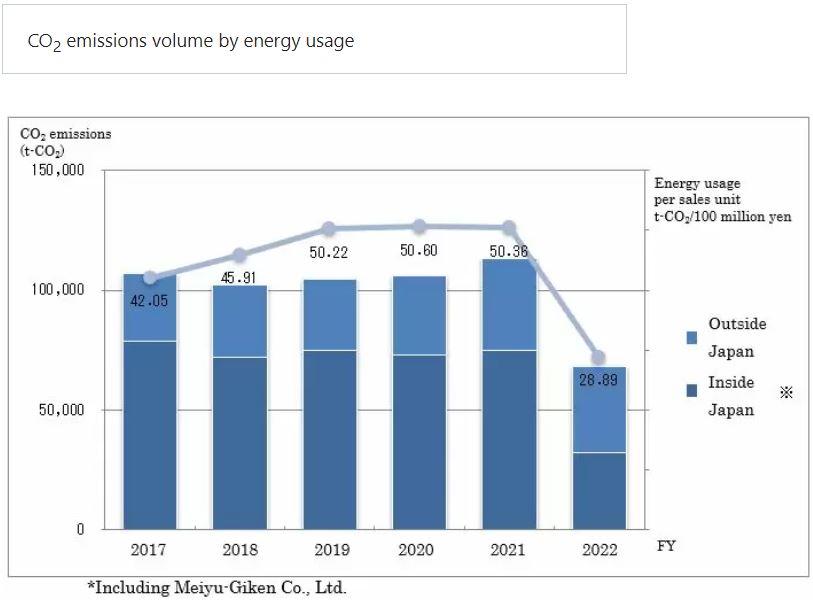
*Energy usage per sales unit (*use the cursor to view definition) is shown as unit of CO2 emissions in Japan and overseas, and consolidated net sales (unit: t-CO2/100 million yen)
* The equivalency factor for CO2 emissions due to domestic energy use is based on the value published by each electric power company in the Ministry of the Environment’s list of calculation methods and emission factors.
To reduce future CO2 emissions, JAE will work to achieve the following targets (CO2 emissions from Scope 1 and 2 production sites in Japan and overseas), looking to achieve net-zero CO2 emissions by 2050, in accordance with the government’s policy.
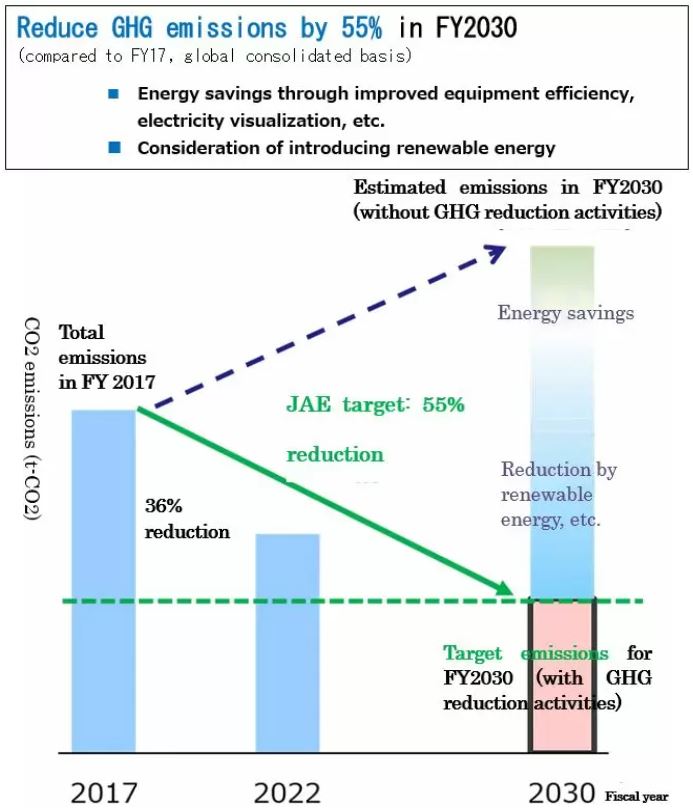
CO2 emissions were reduced by 36% (compared to 2017) due to the introduction of renewable energy and energy conservation efforts in 2022.
In addition, as a Groupwide activity that includes overseas production sites, we will continue to monitor our electricity consumption, total CO2 emissions, and emissions per sales primary unit, while further promoting energy savings in infrastructure and introducing efficient production. With regard to energy conservation, measures have been formulated and implemented at each site since 2022, with the aim of doubling the previous target. Last year, we also received an energy-saving diagnosis by an outside expert and will continue to promote energy saving.
Status of response to SBT
The JAE Group has received SBT 1.5℃ certification from SBTi as part of the NEC Group. Furthermore, greenhouse gas emissions (Scopes 1 and 2) data, following the Akishima Plant and HAE, other production sites, will also undergo third-party verification and certification.The Group will continue to maintain the accuracy of aggregated values and improve the efficiency of aggregation methods.
Status of progress toward uniform goals in the electrical and electronics industries
The JAE Group in Japan participates in the electrical and electronics industries’ Action Plan for Carbon Neutrality and is progressing toward the goal of a 1% annual average energy efficiency improvement in production processes through 2030.We will continue to curb energy usage per unit by taking steps to contribute to energy savings.
Status of Response to Tokyo Cap-and-Trade Program
During the second compliance period from fiscal 2020 to fiscal 2024, companies must reduce CO2 emissions by an average of 25%, but due to the launch of new products, we did not meet the 25% reduction target from standard emissions in fiscal 2022 for a single fiscal year. At this rate, achieving the required reductions will be difficult, and so we will go even further in pursuing measures to address climate change, including introducing renewable energy.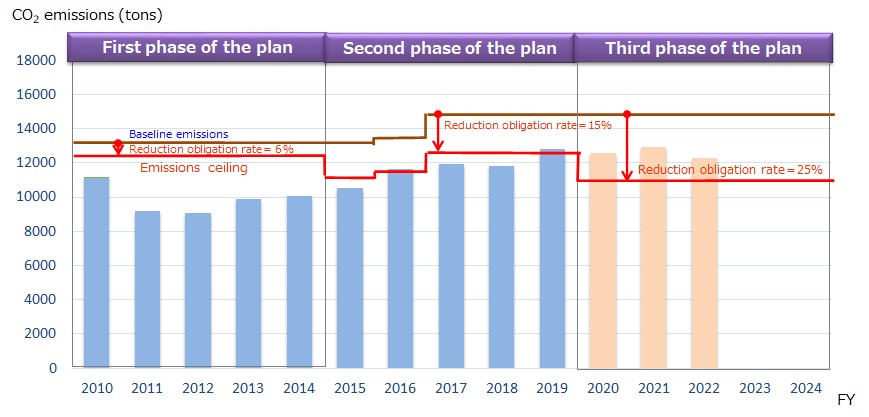
Contribution of the JAE Group Forest
The Group has estimated that the amount of greenhouse gases (CO2) absorbed through the planting of Japanese cypress and broadleaf trees in the JAE Group Forest is about 5.3 tons-CO2 per year.Fiscal 2022 Energy Conservation Case Studies
Plants and related facilities and production system
| Implementation details (1) | ||
| Reduction of power consumption by turning heaters off at production facilities (print curing furnaces) when not in operation (UIS) |
The print curing furnaces used in production were always operated with the heater on to ensure stable quality, but after conducting stability evaluation checks targeting low-impact processes, we were able to turn the heater off during non-operating hours. Energy consumption was reduced by progressively adopting this method. | |
| Effect | Notes | |
| Approx. 567,594 kWh/year |
― |
|
| Implementation details (2) | ||
| Reduction of power consumption through compressor replacement (HAE) | The compressor that pumps air into the plant which is installed in the power building was replaced with an energy-saving unit to save electricity. | |
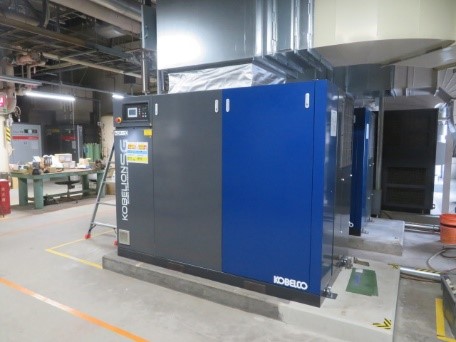 |
Effect | Notes |
| 340,323 kWh/year |
― | |
| Implementation details (3) | ||
| Power reduction through replacement of high-efficiency transformers (YAE) |
In fiscal 2022, two transformers used in Building A of Factory No. 1 were replaced with the following reduced loss transformers to reduce power consumption. - Adoption of high-performance low-loss iron core materials ⇒ Reduction of no-load loss (loss caused by the iron core that is constantly generated) - Adoption of low load loss products ⇒ Reduction of load loss (loss due to copper wire resistance caused by current flow) |
|
| Effect | Notes | |
| 41,520 kWh/year |
― | |
JAE lighting
| Implementation details (1) | ||
| Switched to LED lighting (JAE) |
|
|
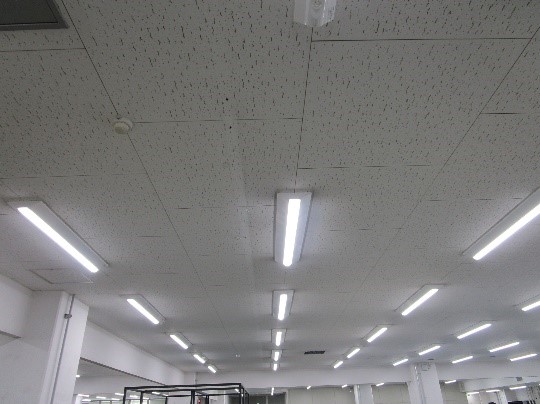 |
Effect | Notes |
| Total of 20,176 kWh/year |
Lights in buildings have been systematically changed to LED lighting since fiscal 2013. We plan to systematically update lighting in the welfare office building and Factory No. 1 floors that has become outdated. As of the end of fiscal 2022 4,609 LED lights out of 11,004 lights Progress rate: 42% |
|
Activities of overseas production bases
| Implementation details (1) | ||
Lighting improvement (JAE-WX)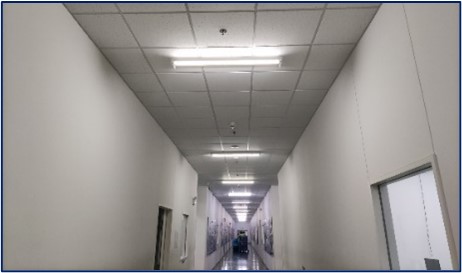 |
Special ordered energy-saving LED lighting and changed the output (from 18W to 8W) and adjusted the brightness without affecting the production site. Replaced a total of 986 lights with energy-saving LED lighting. |
|
| Effect | Notes | |
|
87,393 kWh/year
|
ー | |
| Implementation details (2) | ||
|
Factory energy saving activities (JAE-WJ)
Replaced with LED lighting
Improvement of nighttime outdoor projection lighting 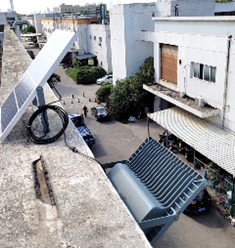  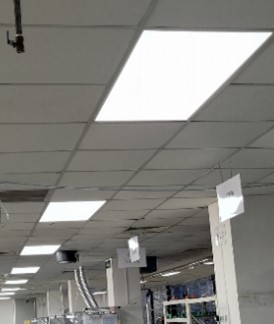 |
Improved electricity savings.
|
|
| Effect | Notes | |
| Total of 40,564 kWh/year | ― | |
Logistics related
1) CO2 reductions from modal shift (railway transport)
Reduced CO2 emissions by switching from truck transport (crates) to railway transport (containers)
CO2 emissions were reduced by 4.2571 tons (compared to truck transport)
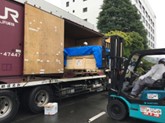
2) CO2 emissions reductions by using reusable trays
CO2 emissions were reduced by reusing trays for connectors.
CO2 emissions reductions = 84.6396 tons
*33.92 tons of reusable trays/year x conversion factor of 2.55 CO2/tons = 84.6396 tons
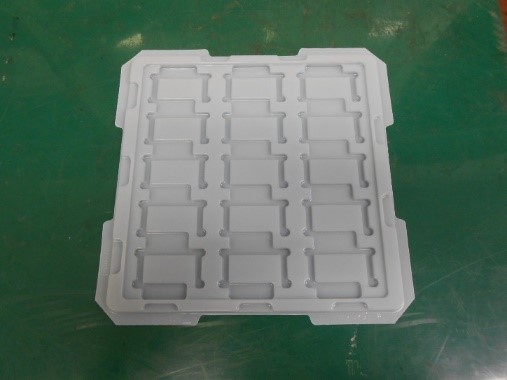
Activities to Increase Awareness of Measures to Fight Climate Change
Introduced here are several fiscal 2022 efforts made to increase awareness of climate change measures.Environment Month publicity and a wide range of Environment Month activities were held at each site.
- Eco-driving training
- Clean up campaign around each work site, and other activities
All employees of the JAE Group in Japan took part in e-learning.
(For details, see the Environmental Education section) (click to open)
● Warm Biz and Cool Biz
- Cool Biz (May 1 through October 31)
- Warm Biz (December 1 through March 3
Measures to Fight Climate Change through Supply Chain Cooperation
The JAE Group asks its domestic business partners to agree to and implement greenhouse gas emission reductions in line with its CSR guidelines, and it is taking measures to fight global warming throughout the supply chain.Building a Sustainable World
Significance of the 2023 Environmental Report
Symbol of the Group's Environmental Policies
Scope of Reporting and Editorial Policy
Policies and Results of Environmental Activities
Environmental Management
- Implementation Status of the Environmental Management System
- Environmental Audits
- Environmental Education
- Environmental Risk Management
- Environmental Accounting
Engaging with Society
- Involvement with Biodiversity
- Supply Chain Management
- Eco-Friendly Products
- Social contribution activities
Initiatives to Reduce Environmental Impact